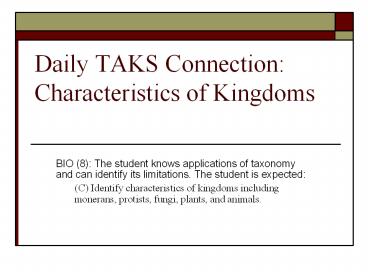Daily TAKS Connection: Characteristics of Kingdoms - PowerPoint PPT Presentation
1 / 16
Title:
Daily TAKS Connection: Characteristics of Kingdoms
Description:
Daily TAKS Connection: Characteristics of Kingdoms BIO (8): The student knows applications of taxonomy and can identify its limitations. The student is expected: – PowerPoint PPT presentation
Number of Views:59
Avg rating:3.0/5.0
Title: Daily TAKS Connection: Characteristics of Kingdoms
1
Daily TAKS ConnectionCharacteristics of
Kingdoms
- BIO (8) The student knows applications of
taxonomy and can identify its limitations. The
student is expected - (C) Identify characteristics of kingdoms
including monerans, protists, fungi, plants, and
animals.
2
Foldable Instructions
- Construct a layered book foldable
- Materials
- Foldable handout (3 pages)
- Scissors
- Pen
- Colored pencils/crayons
- Stapler
- Instructions ?????
3
Archaebacteria Notes
- On the tab labeled Archaebacteria, record the
following notes - Prokaryotic
- No nucleus
- No membrane-bound organelles
- Most have cell walls
- Single-celled
- Both autotrophs and heterotrophs exist
- Reproduce by asexual reproduction
- Also called extremophiles because they live in
extreme environments (extremely hot, salty, or
acidic environments)
4
Eubacteria Notes
- On the tab labeled Eubacteria, record the
following notes - Prokaryotic
- No nucleus
- No membrane-bound organelles
- Most have cell walls
- Single-celled
- Both autotrophic and heterotrophic exist
- Reproduce by asexual reproduction
- Most abundant kingdom on earth
5
Protist Notes
- On the tab labeled Protists, record the
following notes - Eukaryotic
- Contain a nucleus
- Contain membrane bound organelles
- Unicellular and multicellular exist
- Both autotrophs and heterotrophs exist
- Examples euglena, paramecium, amoeba
6
Fungi Notes
- On the tab labeled Fungi, record the following
notes - Eukaryotic
- Multicellular
- Have a cell wall
- Lack chloroplasts
- Heterotrophic
- Decomposers
- Can reproduce by both sexual reproduction
(produce spores) and asexual reproduction - non-motile
- Examples mushrooms and mold
7
Plant Notes
- On the tab labeled Plants, record the following
notes - Eukaryotic
- Multicellular
- Autotrophic
- Contain chloroplasts
- Makes own food by photosynthesis
- Have a cell wall
- Most reproduce by sexual reproduction
- Non-motile
8
Animal Notes
- On the tab labeled Animals, record the
following notes - Eukaryotic
- Multicellular
- Heterotrophic
- No cell wall
- Reproduce by sexual reproduction
- Motile
9
Question 1
- The kingdom Animalia includes all of these except
- a. jellyfish
- b. paramecium
- c. sponges
- d. roundworms
10
Question 2
- Which is a characteristic of members of the plant
kingdom that distinguishes them from members of
the animal kingdom? - a. Storage of energy in chemical bonds
- b. Use of mRNA during protein production
- c. Exchange of H2O with the environment
- d. Use of chlorophyll for solar-energy
transformation
11
Question 3
- This organism most likely is a member of which
kingdom? - a. Eubacteria
- b. Animalia
- c. Protista
- d. Plantae
12
Taxonomy Notes
- On the reverse of your foldable, record the
following - Taxonomic Hierarchy a scientific classification
system - Organisms are most closely related when the their
names contain the same genus.
Kingdom (least specific) King
Phylum Phillip
Class came
Order over
Family for
Genus good
Species (most specific) soup.
13
Question 4
- Which of these classifications is least specific?
- a. Family
- b. Genus
- c. Phylum
- d. Order
14
Question 5
- Which of these classifications is most specific?
- a. Family
- b. Genus
- c. Phylum
- d. Order
15
Question 6
- The bullfrog, Rana catesbeiana, is most closely
related to the - a. spotted chorus frog, Pseudacris clarki
- b. Asian flying frog, Polypedates leucomystax
- c. northern leopard frog, Rana pipiens
- d. African bullfrog, Pyxicephalus adspersus
16
Kingdom Trait Vocabulary Match
- Match the kingdom with the correct characteristics































